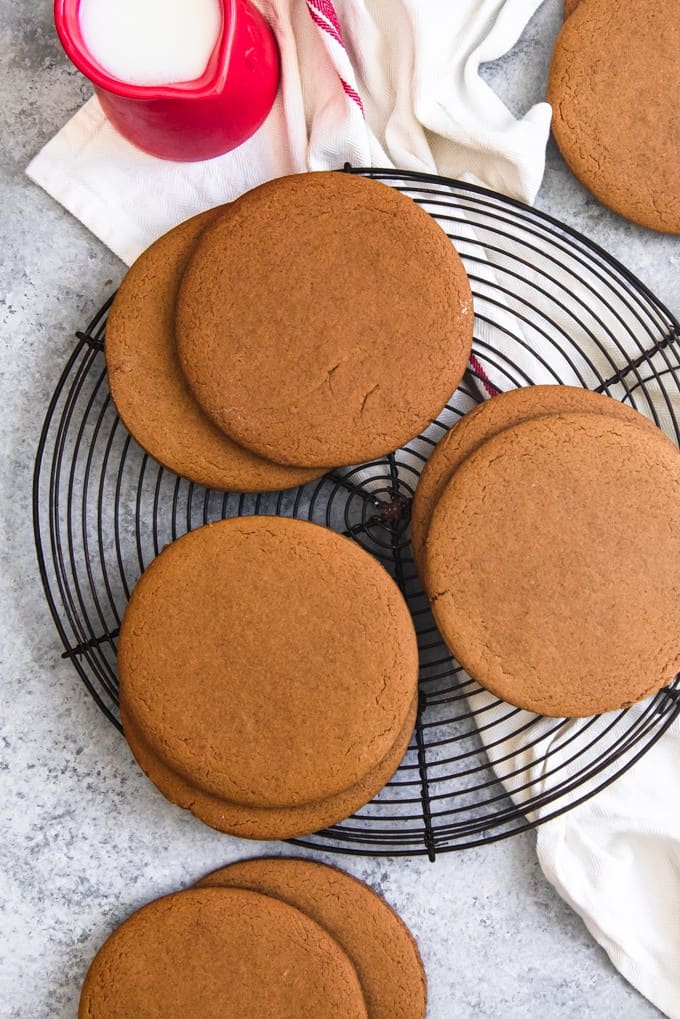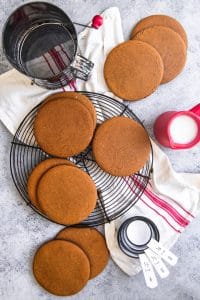We love old-fashioned cookie recipes! Some of our other favorites are Lime Meltaway Shortbread Cookies, Oatmeal Fudge Bars, and Oatmeal Rolled Sugar Cookies.
Joe Froggers Cookies
Last 4th of July, my family visited the Colonial Fest in Orem, Utah, which is part of the area’s larger Freedom Festival celebration. As part of the festival, there are demonstrations and reenactments of colonial life, including debates, storytelling, and “citizens” being mustered into the colonial army. We loved getting our silhouettes made right in front of us by an artist who used tiny scissors to create incredible renditions of each of our profiles. But we especially liked the booth that sold baked goods from the Revolutionary War era, including these Joe Froggers cookies. With Independence Day just around the corner, my blogging friend Jenni, from The Gingered Whisk, and I decided to share recipes popular during the Revolutionary War for our next installment in the Historically Hungry series.
Joe Froggers History
While waiting for our Joe Froggers at the colonial fest, I learned a little about the history of these molasses-spice cookies that I have since learned may or may not be entirely accurate, although it makes for a fun story, regardless of whether it is fact or merely legend. As it goes, there was a free African American man named Joseph Brown who ran a tavern (possibly called Black Joe’s Tavern) with his wife, Lucretia, in Marblehead, Massachusetts. The tavern was located next to a frog-filled pond, and popular amongst the sailors and fishermen who would visit the town. Supposedly, Lucretia decided to make the cookies extra large – the size of the lilypads in the pond – hence the name “froggers”. The soft, sweet, chewy cookies stayed that way–soft, sweet, and chewy–for a long time without going stale, thanks, perhaps, to the molasses, rum, and lack of eggs, that are the signature hallmarks of a Joe Frogger cookie. And they were made large – about 6 inches in diameter or the size of a salad plate. Apparently, the fishermen and sailors loved taking a treat with them out to sea that wouldn’t go bad quickly so they could have something sweet to eat. Although no one is quite certain of the exact original recipe, very little has likely changed over the years, with the notable exception of eliminating “seawater”, which I saw mentioned as a possible original ingredient by at least one source. But essentially, the recipe is based on a standard gingerbread or molasses cookie recipe: flour, sugar, butter, molasses, and spices. It’s an egg-free recipe, just in case anyone is wondering if they were left out of the recipe by accident.
How to Make Joe Froggers Cookies
Recipe Tips
I wouldn’t try to make these by hand. A stand mixer with a paddle attachment makes it so much easier. You could use real rum if you have it on hand. Other recipes I saw called for 3 ½ tablespoons of rum. I used 1 teaspoon of rum extract, instead, which I always have on hand because I use it for things like homemade eggnog (another historically hungry post!). The dough is pretty sticky, which is why it needs to be refrigerated for at least 2 hours, or even overnight. Only work with one disc of dough at a time and leave the other in the fridge so it stays cold. If you cook your Joe Froggers a little too long and they get harder than you would like, no worries–these cookies are perfect for dunking in milk! Although you have to break them into pieces to get them to fit into the glass.
More Old-Fashioned Cookie Recipes
Soft & Chewy Molasses Cookies Oatmeal Rolled Sugar Cookies The Best Snickerdoodle Cookies Recipe Best Cut-Out Sugar Cookies Soft & Chewy Gingerbread Men Cookies
Also, be sure to check out Jenni’s Historically Hungry Revolutionary War recipe–George Washington’s Carrot Tea Cake. Let me know what you thought with a comment and rating below. You can also take a picture and tag me on Instagram @houseofnasheats or share it on the Pinterest pin so I can see.




